As an Amazon Associate we earn from qualifying purchases.
Do you want to provide the local deer with a place to get a bite to eat? If you enjoy admiring these beautiful creatures, then there are multiple ideas for building a feeder for them. There’s no reason to throw a bunch of money at purchasing a fancy feeder, as they’re not necessary. There are many DIY deer feeder projects that you can create for yourself.
Even if you’re an amateur, you can easily build many of these deer feeder ideas within an hour or two. You may even have most of the material lying around in your garage, collecting dust. Below are ideas to inspire you to build a deer feeder, without going over budget.
While you’re at it, take a look at my DIY horse feeder ideas!
Contents
- 1. PVC Pipe Deer Feeder
- 2. Deer Feeder with a Roof
- 3. Large Trough-Style Deer Feeder
- 4. Bucket and PVC Pipe Deer Feeder
- 5. Slanted Roof Deer Feeder
- 6. Corn Trough Feeder
- 7. Camouflage Deer Feeder
- 8. Small Tree Deer Feeder
- 9. Wooden Deer Feeder with Storage
- 10. Tripod Deer Feeder
- 11. Hanging Bucket Deer Feeder
- Your Turn to Create a DIY Deer Feeder!
1. PVC Pipe Deer Feeder
You can easily obtain PVC pipe from your local home improvement stores, such as The Home Depot or Lowe’s. This photo shows you how simple it is to create a deer feeder out of a few sections of pipe. You load the deer feed into the opening at the top and it drops down for the deer to reach.

You can get the details of the project here: outdoorempire.com
This is one of the easiest DIY deer feeder ideas, as it requires no special tools. You can easily throw together this feeder within a couple of hours and the local deer will love you for it. They’ll routinely come back once they know where the food is.
While you don’t need any specific tools, a circular saw will help you cut the PVC pipe quicker.
This is another angle of the PVC pipe feeder, where you can see the cap placed onto the top. This prevents any other animal from consuming the food through the top section. You can choose to attach the pipe to a tree or another sturdy object, as it won’t stand up straight on its own.
If you want a more in-depth tutorial on how to build this feeder, this video provides you with step-by-step instructions. It can be helpful to follow along and pause the video in sections so that you can catch up and work alongside the individual in the video.
2. Deer Feeder with a Roof
If you want to keep your deer feed from getting damp from rainy weather, you can choose to build a small roof to protect the food. This is an example of such a feeder. You would simply pour the deer food into the trough section of the feeder and deer can eat from both sides.
For more ideas, check it out here: hurleybyrd.com
This is a great design because several deer can eat at once. This is unlike the PVC feeder idea, as only one deer can eat at a time. If you live in a rainy or otherwise damp environment, this is a great feeder idea.
Once deer food gets wet and moist, it can become moldy. This won’t be good for the deer to consume and you don’t want to get them sick. This is why the roof over the feed is a great idea for your DIY project.
3. Large Trough-Style Deer Feeder
If you want to invite multiple deer to eat at once, you’ll want to build a larger feeder. As you can see from the photo, this feeder attracts several bucks at once. Depending on the size of your property, you may have a larger herd of deer that you want to feed at once.
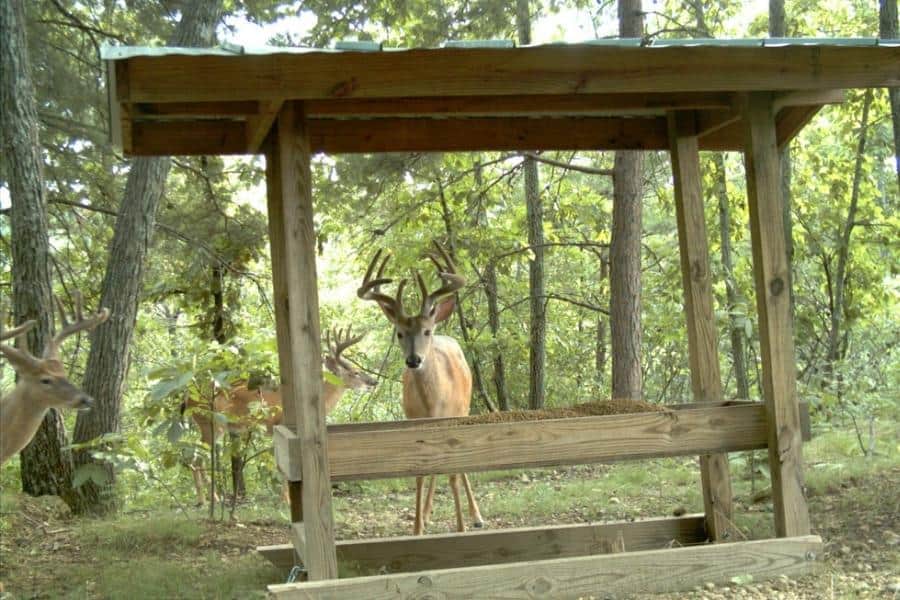
You can view the detailed idea here: mossyoak.com
This particular feeder has a roof, similar to the one in idea #2. This is great to protect the food from the elements and keep it from collecting water. The deer will appreciate this small addition, as it makes a large difference.
If you’re unsure how to build such a feeder, this video is a great resource for you. You’ll be walked step-by-step through the process of building this wooden deer feeder. Even a beginner can follow along and successfully create their own!
4. Bucket and PVC Pipe Deer Feeder
If you don’t have all of the pieces for the PVC pipe feeder but you do have an unused bucket, you can attempt to create this DIY deer feeder. This is an easy feeder to make and could be completed within a couple of hours.
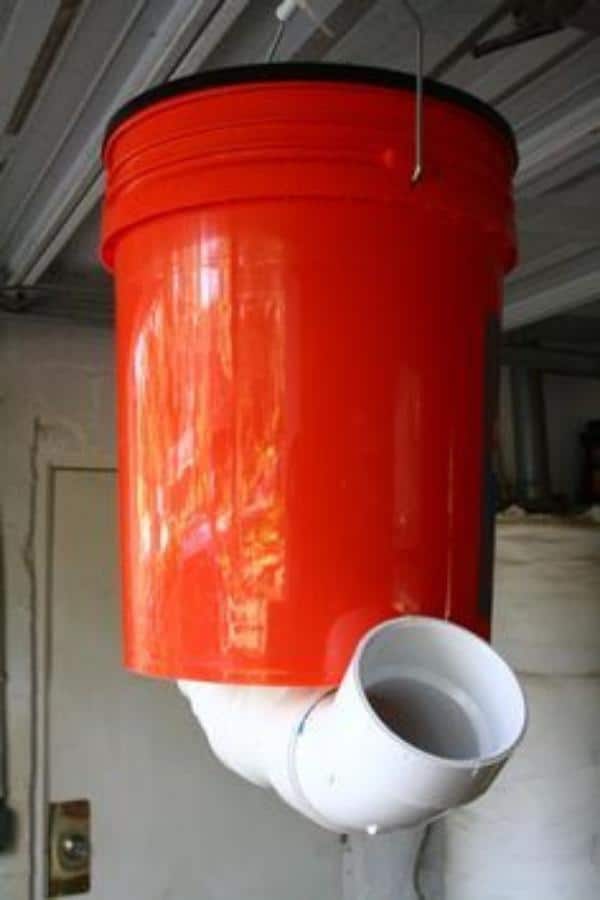
Check the DIY deer feeder here: pinterest.com
If you don’t like the color of the bucket, you could spray paint it so that it blends in better with the surrounding greenery. You would simply load the food into the top part of the bucket and it will drain down through the pipe section.
It’s important to have a curved section of PVC pipe for the bottom or else the food will spill out all over the ground. When the pipe is curved upwards by a bit, it allows the food to gather for the deer to eat.
5. Slanted Roof Deer Feeder
This feeder has a corrugated tin roof, which is built at a slant. This allows the water to slide off of the roof so that the feed stays dry and protected. This feeder also has divided sections for the food, so that the deer can share the feeder simultaneously.
You can check the details here: pinterest.com
This is a great design for a DIY build, as it takes some wood and a bit of corrugated tin for the top. You could put this together in an afternoon and with a few select tools, depending on what cuts you need to make for the metal roofing. It’s important to build the feeder off of the ground, so the deer have an easier time leaning down to eat.
This is a similar design for a deer feeder, with a flat corrugated roof instead of one at a slant. Instead of the wooden boxes for the feed, it has two halves of a blue bin. This is great if you have these materials lying around and you want to put them to use.
6. Corn Trough Feeder
This is the perfect DIY deer feeder if you have a corn trough lying around, not being used. You can simply cut the trough in half and use the resulting halves for placing the deer feed into. This deer feeder also features a reused pallet, instead of new wood. This results in a very budget-friendly DIY deer feeder.
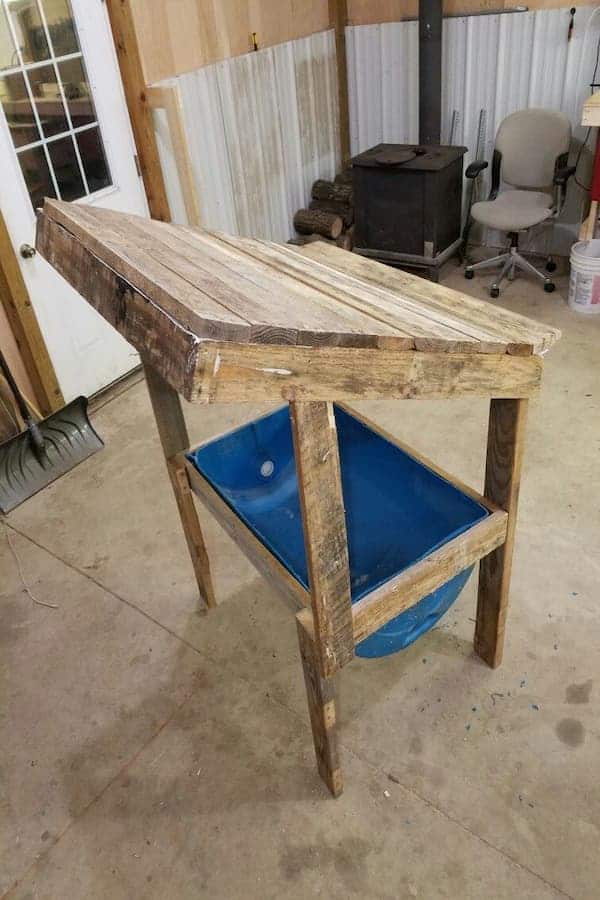
You can check the project idea here: pinterest.com
This particular design features a slanted wooden roof, which protects the food from the rainy elements. The halved corn trough holds a great deal of feed, so you don’t have to worry about constantly refilling it.
While this is a smaller version of such a design, you could expand the feeder and make it large enough for multiple deer to use it at once. You’ll have to beware that other animals could potentially eat from this feeder as well — not just deer.
If you want to avoid this, you should look into deer feeders with scheduled dispensing times. This way, the feed will be automatically released at specified times that you’ve set. This keeps the feed from sitting out for other animals to consume it before the deer gets a chance to.
7. Camouflage Deer Feeder
If you want your deer feeder to blend in with the surrounding area, you can paint it in a camouflage style. This design features a corrugated tin roof, to protect the feed bucket. The feed is also raised a good height from the ground, granting the deer easy access to their food.

You can check the project idea here: pinterest.com
You can place half of a corn trough into this feeder if you want to hold more feed at once. The above design will have to be refilled frequently, as it doesn’t hold a large amount at once. However, the painted design makes this feeder worthy of a spot on this list.
If you want a solution for this feeder not holding a large amount of feed at once, you can simply build a deeper container. That way, you can fill it up with as much feed as you deem necessary. This is a simple solution to the above design and will enable this feeder to suit your needs.
8. Small Tree Deer Feeder
If you don’t require a large feeder, you can build a smaller one to attach to a nearby tree. This type of feeder is relatively easy to construct and doesn’t require any expert skills. You can remove the top to place the feed into the box.

You can view the detailed project here: feltmagnet.com
You need basic skills of woodworking to craft this feeder, but a beginner could likely succeed in making this wood project. Without any electric tools, this DIY feeder may take you several hours — but it’s manageable and you’ll have a solid deer feeder by the end.
9. Wooden Deer Feeder with Storage
If you don’t want to be constantly refilling your deer feeder with corn, you can opt for this type of design. You’ll be able to open the roof of the storage at the top to fill up the feeder with deer food. Then, it’ll drain by itself into the bottom of the feeder so that the deer can get to it.
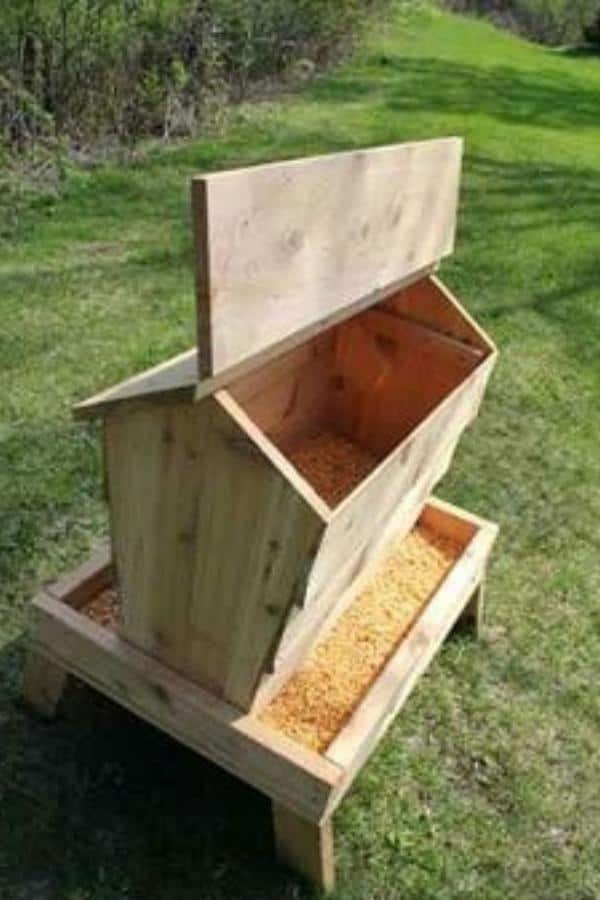
Check the detailed project here: outdoorempire.com
If you want to forget about your feeder for weeks on end, this is a great option for you. Just load the feeder up with several gallons of food and you’ll be good to go. This feeder can be made with any scrap wood you have lying around if you don’t want to go over budget by purchasing new boards.
This is a great feeder idea if you want to protect the feed from the elements and also from other animals roaming around the area.
10. Tripod Deer Feeder
This is a popular deer feeder design, as it stands on three legs and is high off the ground. The feeder drops corn down onto the ground for the deer to consume. Also, you can fill up the bucket with a significant amount of feed, so you don’t have to check it very often.
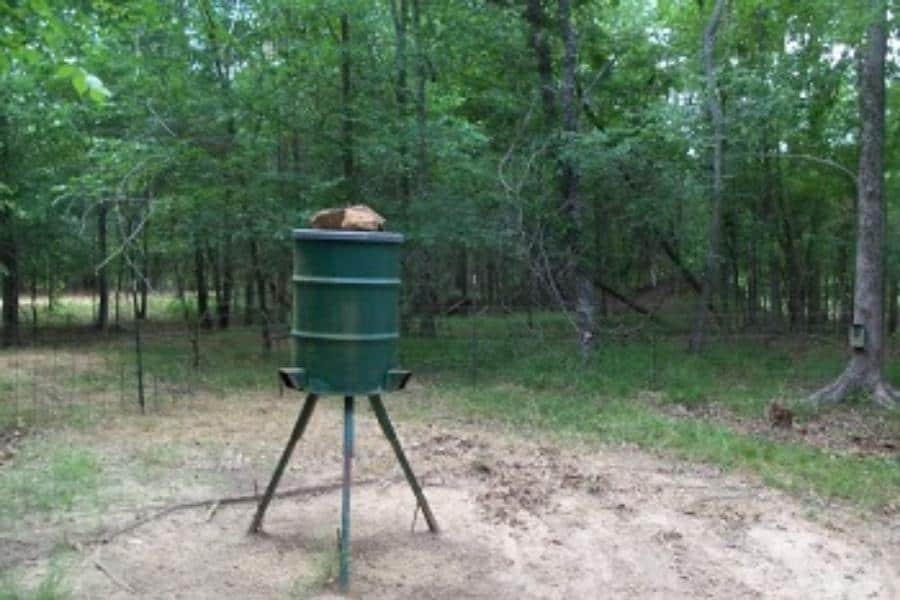
You can check other deer feeder idea here: outdoorempire.com
Once the feeder is empty, the refilling process is straightforward. There is a removable lid on top and you would just dump the new deer feed into the bucket this way.
You can set this type of feeder to automatically dispense the food, based on the schedule that you set. This is a great option if you don’t want the food to be sitting out all day but only at specified times, such as in the evening or morning.
The feed is stored in a large bucket, so it’s protected from the elements. Ideally, it shouldn’t last too long once it’s been dispensed onto the ground — as there should be deer there to consume it quickly. This helps the feed to last without getting moldy or being left out for other critters to consume it (squirrels, mice, birds, etc.)
11. Hanging Bucket Deer Feeder
If you want to throw a deer feeder up within an hour and you have a bucket and some hooks lying around, try this design out. This is a great budget-friendly option that doesn’t require any skill to build.

Check the project idea here: pinterest.com
Just choose a bucket or other vessel to hang from a low branch and then fill it up with dried corn for the deer. You can store as much or as little as you’d like inside of the bucket. However, be careful if the weather is forecasting rain because there is no protection, such as a roof, over the feed.
If you need a quick solution for a deer feeder, this is one of your best options. It’s cheap, it’s simple, and it works. The deer don’t care if their food is in a fancy camouflage painted feeder or inside of a blue bucket — it’s all the same to them.
Your Turn to Create a DIY Deer Feeder!
There are so many great options for creating your DIY deer feeder. If you’ve seen deer milling around your yard and want to invite them over for some food, then you can gather the materials and have a feeder built within a few hours or over a weekend. There’s no reason to go out and purchase an expensive feeder that does the same job.
Many of the above ideas required materials you may even have around your yard or in your garage. Old pallets, a corn trough, or even some scrap wood can be used to create a deer feeder. You can even use PVC pipe for an incredibly simple DIY deer feeding solution!
Whichever option you choose, you’re sure to be loved by the neighborhood deer. They’ll enjoy the food that you’ve provided and you can enjoy watching them hang out nearby. It’s a win for everybody.
